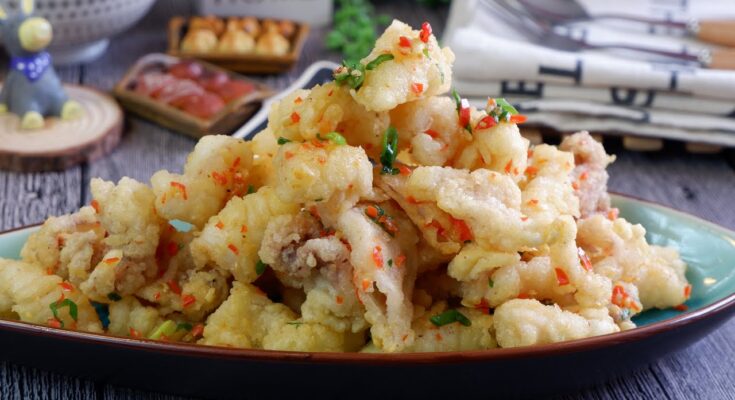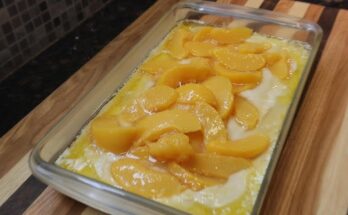Calamari Dish Recipe: There’s something magical about that first bite of crispy, golden calamari. Whether you’ve had it as a starter at a fancy restaurant or as a quick bar snack, it’s always a crowd-pleaser. But guess what? You don’t have to wait until your next dinner reservation to enjoy it. You can whip up this restaurant-quality calamari dish right at home—and it’s way easier than you think.
Calamari, also known as squid, is a delicacy that’s enjoyed all around the world. From Mediterranean coasts to Asian street food stalls, everyone has their own spin on this tender and tasty seafood. But when it comes to the classic deep-fried calamari—crispy on the outside, tender on the inside—that’s where this recipe comes in.
In this guide, we’re breaking it all down for you. Step by step. Ingredient by ingredient. Whether you’re a total newbie in the kitchen or a seasoned cook looking for a flawless calamari method, you’ll find everything you need right here. So grab your apron, and let’s dive into the delicious world of calamari!
Ingredients You’ll Need
When it comes to nailing a good calamari dish, starting with the right ingredients is key. You don’t need anything fancy—just the basics done right. But before we list everything, let’s get into a common kitchen debate: fresh vs. frozen calamari.
Fresh vs Frozen Calamari: What to Choose
Fresh calamari is ideal if you can get your hands on it. It’s tender, flavorful, and usually needs minimal prep. But don’t worry if your local grocery store only stocks frozen squid—it’s still a great option. Just make sure to thaw it properly (in the fridge overnight or in cold water for a few hours) before cooking.
Core Ingredients
Here’s everything you’ll need for the basic calamari dish:
- 1 pound of calamari (squid), cleaned
- 1 cup all-purpose flour
- 1 cup cornmeal or breadcrumbs (optional for extra crunch)
- 1 teaspoon salt
- 1/2 teaspoon black pepper
- 1/2 teaspoon garlic powder
- 1/2 teaspoon paprika (optional for flavor and color)
- 2 eggs (for dredging)
- Vegetable or canola oil (for frying)
Optional Add-Ons for Extra Flavor
- Lemon wedges (for garnish and flavor)
- Fresh parsley (finely chopped)
- Chili flakes (for a spicy kick)
- Grated Parmesan (for Italian-style twist)
These ingredients form the heart of your calamari recipe. The best part? You can tweak them based on your taste. Don’t like garlic? Skip it. Want it extra crispy? Go heavy on the breadcrumbs.
Tools and Equipment
Cooking great calamari isn’t just about the ingredients—it’s also about using the right tools. Here’s a quick list of what you’ll need to make the process smooth and safe.
Kitchen Tools You’ll Need
- Sharp knife (for slicing calamari)
- Cutting board
- Mixing bowls (for flour, eggs, and breading)
- Tongs or a slotted spoon (to flip and remove from oil)
- Deep pan or heavy-bottomed skillet (for frying)
- Paper towels (for draining excess oil)
- Thermometer (to check oil temperature)
Safety Tips When Handling Calamari
- Always keep seafood cold until you’re ready to cook.
- Make sure the oil is hot enough before frying—if it’s too cold, your calamari will get soggy.
- Avoid overcrowding the pan. Fry in small batches.
- Keep a splatter guard or lid handy—hot oil can pop!
Now that your kitchen is stocked and ready, let’s get into prepping this delicious dish.
Preparation Tips
Let’s be honest—handling calamari might feel a bit intimidating at first. All those tubes and tentacles? Totally normal to be unsure about what goes where. But don’t worry—once you learn the basics, prepping squid is actually super straightforward. And getting the prep right? That’s the key to that perfect golden crunch and tender bite.
How to Clean and Prep Calamari
If you’re working with fresh, whole squid, here’s how to clean it:
- Separate the tentacles: Hold the squid firmly and gently pull the head and tentacles away from the body. Most of the internal parts will come out attached to the head.
- Remove the beak: Cut just below the eyes and squeeze to pop out the small beak (mouth). Discard it.
- Clean the body: Pull out the clear cartilage inside the tube—it looks like a piece of plastic. Then rinse the inside of the tube under cold water.
- Peel the skin: Optional, but removing the purple skin gives you that restaurant-style white calamari. Use your fingers or a paper towel to rub it off.
- Pat it dry: Always dry your squid well with paper towels. Moisture will mess up the breading and oil temperature.
Slicing Rings vs Using Whole Tubes
Most people prefer calamari rings. To slice the tubes:
- Cut the body into ½-inch thick rings.
- Keep the tentacles too—they fry up deliciously crispy and flavorful.
Want a more gourmet presentation? You can stuff and bake whole tubes as well. But for this recipe, we’re keeping it classic with fried rings and tentacles.
Marinating for Maximum Flavor
Here’s a trick that takes your calamari from good to restaurant-level: marinate it. A quick soak in a seasoned buttermilk or lemon juice mixture makes the squid more tender and adds layers of flavor.
Try this easy marinade:
- 1 cup buttermilk or milk + a tablespoon of lemon juice
- ½ tsp salt
- ½ tsp garlic powder
- ¼ tsp cayenne pepper (optional)
Let the squid soak for 30 minutes to an hour in the fridge. This will also help the breading stick better. Once marinated, make sure to pat it dry again before dredging.
Step-by-Step Guide to Cooking Calamari
Ready to turn those little rings of squid into golden, crispy bites of joy? Let’s get cooking! Follow these steps exactly, and you’ll never order calamari from a restaurant again—you’ll be the one serving it.
Step 1: Clean the Calamari Thoroughly
We’ve already gone through cleaning, but just a reminder—this step is crucial. Any leftover cartilage, skin, or internal bits will ruin the texture. Make sure everything is well rinsed and dried. This gives you that clean, tender bite without any rubberiness.
Step 2: Slice Calamari into Rings
Use a sharp knife to cut the body into even rings, about ½ inch thick. Uniform pieces help ensure even cooking. Don’t forget those tentacles—they might look weird to some, but they crisp up beautifully and are full of flavor.
Step 3: Prepare the Breading Station
Set up a dredging station with three bowls:
- Bowl 1: Seasoned flour (flour, salt, pepper, garlic powder, paprika)
- Bowl 2: Lightly beaten eggs
- Bowl 3: Optional breadcrumb or cornmeal mixture (for added crunch)
Here’s a quick tip: double-dipping (flour → egg → flour again) makes for a thicker, crunchier crust. Want it super light? Just do one coat.
Step 4: Heat the Oil to the Right Temperature
Pour about 2 inches of oil into a deep skillet or pot. Heat it to 350°F (175°C). Use a thermometer if you have one—getting the oil hot enough is critical.
Too cool = soggy squid.
Too hot = burned coating, raw inside.
Test the oil by dropping in a bit of batter—if it sizzles and rises to the top quickly, it’s ready.
Step 5: Fry the Calamari (Golden & Crispy Tips)
Using tongs, carefully place a few pieces of dredged calamari into the hot oil. Don’t overcrowd the pan—this drops the oil temp and leads to soggy rings.
Fry for just 1½ to 2 minutes per batch. That’s it! Squid cooks fast, and anything longer will make it rubbery.
Once golden and crispy, remove the pieces and place them on a paper towel-lined plate to drain.
Step 6: Drain and Rest Before Serving
Let the calamari rest for a minute or two. Sprinkle immediately with sea salt while hot. Resting helps set the crust and keeps it from getting soggy.
Serve hot with lemon wedges and your favorite dipping sauce.
Baking Instead of Frying
Want all the flavor without the frying? You can totally bake your calamari, and it’ll still turn out crisp and delicious (though a bit less indulgent).
Healthier Alternative
Baked calamari is lower in fat and calories, perfect for those watching their intake but still craving that satisfying crunch.
Tips for Crispy Oven-Baked Calamari
- Preheat oven to 425°F (220°C)
- Use panko breadcrumbs for a crunchier texture
- Spray your baking sheet with cooking oil
- Lay the calamari in a single layer—no overlapping
- Spray the top with olive oil or cooking spray
- Bake for 12–15 minutes, flipping halfway through
Optional: broil for 1–2 minutes at the end for an extra-crispy finish.
Serving Suggestions
You’ve just pulled off golden, crispy calamari—now what? It’s time to plate up and wow your guests (or yourself) with the full experience. Calamari is one of those dishes that can be a light appetizer, part of a tapas spread, or even the star of the meal, depending on how you serve it.
Best Dipping Sauces for Calamari
No calamari dish is complete without a killer dipping sauce. Here are a few crowd-pleasers that pair perfectly with that crunchy exterior and tender center:
- Garlic Aioli – Rich, creamy, and full of garlicky goodness. You can make it with just mayo, minced garlic, lemon juice, and a touch of salt.
- Marinara Sauce – A warm, tomato-based sauce adds a slightly sweet and tangy contrast.
- Spicy Sriracha Mayo – Just mix mayo with a dash of sriracha or hot sauce for that fiery kick.
- Tzatziki – For a Mediterranean twist, pair your calamari with this yogurt-based dip full of cucumber, garlic, and dill.
- Sweet Chili Sauce – A sweet-and-spicy combo that’s perfect if you want something light and tangy.
What to Serve Calamari With
Calamari doesn’t have to fly solo. Here are some amazing pairing ideas to turn your plate into a full meal:
- Fresh Garden Salad – The cool crunch of lettuce, cucumber, and cherry tomatoes balances the fried texture.
- Lemon Rice or Orzo Pasta – A great way to complement the citrusy notes of the calamari.
- Garlic Bread – Because why not? It’s all about that golden crunch.
- Grilled Veggies – Zucchini, bell peppers, and eggplant work wonders here.
- White Wine or a Crisp Beer – For drinks, go with something light and refreshing to cut through the richness.
Presentation tip: Serve calamari on a wooden board or large platter with lemon wedges, chopped parsley, and a few dipping sauces on the side. It’s all about those restaurant vibes at home!
Flavor Variations
While the classic fried calamari is always a win, there’s a world of flavors out there waiting to spice up your squid game. Let’s explore a few variations that add flair and global inspiration to your dish.
Spicy Calamari
Want to turn up the heat? Here’s how to make your calamari sizzle:
- Add cayenne pepper or chili powder to the flour mix.
- Toss fried calamari in buffalo sauce or a sriracha glaze.
- Sprinkle red chili flakes after frying.
- Serve with a cool yogurt dip to balance the spice.
Mediterranean Style
This version brings sunshine and sea breeze straight to your plate:
- Season your flour with oregano, thyme, and lemon zest.
- Serve with tzatziki, hummus, and warm pita bread.
- Drizzle a little olive oil and fresh lemon juice just before serving.
Asian-Inspired Calamari
Take it East with bold flavors and unique textures:
- Add five-spice powder or ginger to the flour mix.
- Toss fried calamari in a soy sauce, honey, and sesame glaze.
- Serve with pickled cucumbers and a sprinkle of sesame seeds.
Flavor variations are where you get to be creative—don’t be afraid to experiment. Think of calamari as a blank canvas just waiting for your personal flavor twist.
Storage and Leftovers
Let’s be real—calamari is best enjoyed fresh out of the fryer. That hot, crispy magic just can’t be fully duplicated later. But hey, if you’ve got leftovers (lucky you), there are a few tricks to revive them without turning everything into rubber.
How to Store Fried Calamari
- Allow the calamari to cool completely before storing. Hot calamari in a closed container = soggy city.
- Store in an airtight container lined with a paper towel. This helps absorb any remaining oil.
- Keep in the refrigerator for up to 2 days.
Reheating Tips Without Losing Crisp
Avoid the microwave—it’ll make your calamari rubbery and soggy. Instead, try this:
- Preheat oven to 375°F (190°C)
- Place calamari on a baking sheet lined with foil or parchment
- Heat for 8–10 minutes, flipping halfway through
Alternatively, use an air fryer for 3–4 minutes at 375°F for a faster crisp-up.
Want to get creative? Chop up leftover calamari and toss it into:
- Salads for a protein boost
- Tacos with slaw and spicy mayo
- Pasta dishes for a seafood twist
Common Mistakes to Avoid
Cooking calamari may seem easy, but it’s also easy to mess up. From texture disasters to flavor fails, here are the most common calamari slip-ups and how to steer clear of them.
Overcooking Calamari
This is the #1 mistake. Overcooked calamari turns rubbery, chewy, and downright unpleasant. Remember the rule:
Cook it fast and hot – no more than 2 minutes!
Wrong Oil Temperature
Too cold? The breading soaks up oil and gets soggy. Too hot? The outside burns before the inside cooks.
Aim for 350°F–375°F and monitor with a thermometer. Fry in small batches to keep the oil from cooling too much.
Skipping the Resting Step
After frying, let calamari rest on a paper towel-lined plate for at least 1 minute before serving. This prevents sogginess and sets the crust.
Not Drying the Calamari Properly
Excess moisture = steam = soft, greasy coating. Always pat squid dry before dredging and frying.
Crowding the Pan
Throwing in too many pieces drops the oil temperature and leads to uneven cooking. Fry in small batches—even if it takes longer, it’s worth it.
Avoid these pitfalls, and you’ll serve up perfect calamari every single time.
Tips from Professional Chefs
Want to take your calamari from good to unforgettable? Let’s borrow some wisdom from chefs who’ve mastered the art of frying squid to perfection. These little tweaks can make a huge difference in flavor, texture, and presentation.
Seasoning Secrets
One thing pro chefs never skip? Seasoning—at every stage.
- Season the flour: Don’t just rely on salt at the end. Mix herbs and spices into your flour—think garlic powder, paprika, cayenne, onion powder, lemon zest.
- Season right after frying: Salt sticks better when calamari is hot and just out of the oil. Use fine sea salt or flaky salt for a nice finish.
- For an elevated flavor, sprinkle with lemon zest and fresh herbs (like parsley, dill, or thyme) before serving.
Texture & Crunch Tips
Here’s how chefs get that golden, restaurant-level crunch:
- Use a combo of flour + cornstarch for extra crispiness. A 50/50 mix works wonders.
- Add a small amount of rice flour or semolina for a unique, extra-crunchy bite.
- Let dredged calamari sit on a wire rack for a few minutes before frying. This helps the coating stick and firm up before hitting the oil.
Oil Matters
- Use neutral oils with high smoke points, like vegetable oil, canola, or peanut oil. Avoid olive oil for frying—it can burn and affect flavor.
- Change oil frequently when frying multiple batches. Dirty oil will darken the calamari and give it a bitter taste.
Finishing Touches
- Garnish with microgreens, shaved Parmesan, or fried herbs for a gourmet presentation.
- Serve with a small ramekin of sauce and a lemon wedge wrapped in cheesecloth (prevents seeds from falling into the food—fancy, right?).
Pro tip? Less is more. Don’t overload your plate. A small, beautifully plated pile of calamari is more appealing than a mountain of oily rings.
Nutrition Breakdown
If you’re wondering whether calamari is just an indulgent fried snack or something that can fit into a balanced diet, here’s the good news: it’s both! Calamari itself is quite nutritious, and you can tweak the recipe to make it even healthier.
Calories and Macronutrients (Per Serving – 1 Cup Fried Calamari)
| Nutrient | Amount |
|---|---|
| Calories | ~220–280 kcal |
| Protein | ~15g |
| Fat | ~10–14g |
| Carbohydrates | ~20–25g |
| Cholesterol | ~200mg |
| Sodium | ~300mg |
Note: Values may vary depending on oil used, breading, and frying method.
Health Benefits of Calamari
- High in protein – helps support muscle growth and repair.
- Rich in omega-3 fatty acids – good for heart and brain health.
- Low in carbs (without breading) – fits into low-carb or keto diets.
Want to make it even healthier?
- Use air frying or baking instead of deep-frying.
- Opt for whole wheat breadcrumbs or skip breading entirely.
- Pair with a light salad instead of starchy sides.
Bottom line? Calamari can absolutely be part of a healthy lifestyle—especially when enjoyed in moderation and with smart swaps.
FAQs about Calamari Dish Recipe
1. Is calamari healthy to eat?
Yes! Calamari is low in fat, high in protein, and packed with essential nutrients like vitamin B12, selenium, and omega-3s. Just go easy on the deep-frying or opt for baked versions if you’re watching calories.
2. Can I make calamari gluten-free?
Definitely. Use gluten-free flour or cornstarch for dredging, and skip any breadcrumbs that contain wheat. There are also great gluten-free panko options available in stores.
3. What’s the best oil for frying calamari?
Go with oils that have a high smoke point and neutral flavor. Canola, peanut, sunflower, or vegetable oil are all good choices. Avoid olive oil for frying—it’s better suited for drizzling or dressing.
4. Can I air-fry calamari instead of deep-frying?
Yes, and it’s a great low-fat alternative! Just coat your calamari in seasoned flour or panko, spray lightly with oil, and air fry at 400°F (200°C) for about 6–8 minutes, shaking halfway through.
5. How do I know when calamari is perfectly cooked?
Perfectly cooked calamari should be golden brown on the outside and tender inside. It cooks quickly—usually in 1½ to 2 minutes. If it’s rubbery or chewy, you’ve gone too far.
Conclusion
Cooking calamari at home doesn’t have to be complicated or intimidating. With the right ingredients, a few pro tips, and a bit of patience, you can create a dish that’s every bit as good as what you’d find in a seaside restaurant. Whether you fry, bake, or air-fry, the magic of calamari lies in the crispy coating, the tender bite, and those perfect finishing touches like lemon and dip.
From prepping the squid to mastering the fry time, you’ve now got all the tools to make calamari like a pro. Whether you’re hosting a dinner party, impressing a date, or just treating yourself, this dish is sure to turn heads and fill bellies.
So next time you’re craving something crispy, flavorful, and a little fancy, skip the takeout. Grab some squid, heat up that oil, and fry up a batch of homemade calamari you’ll be proud of.



